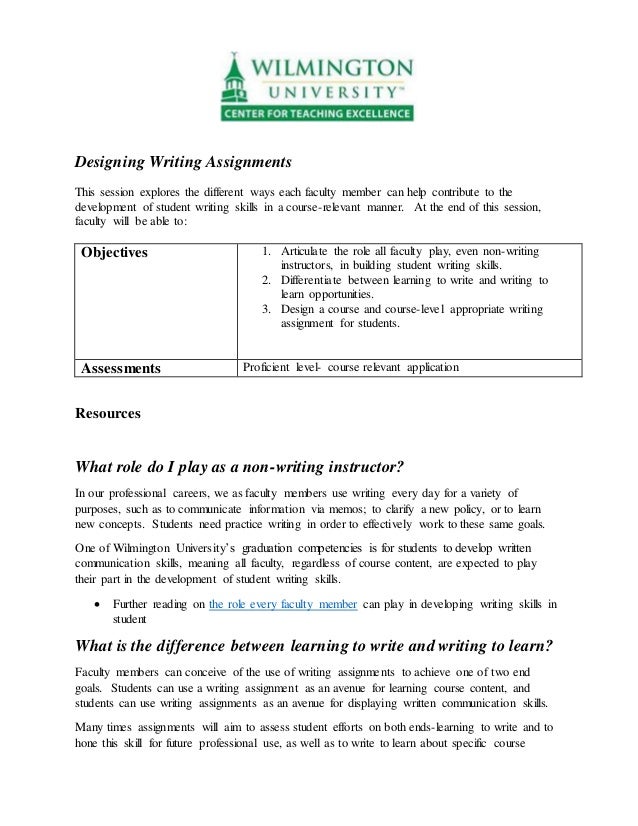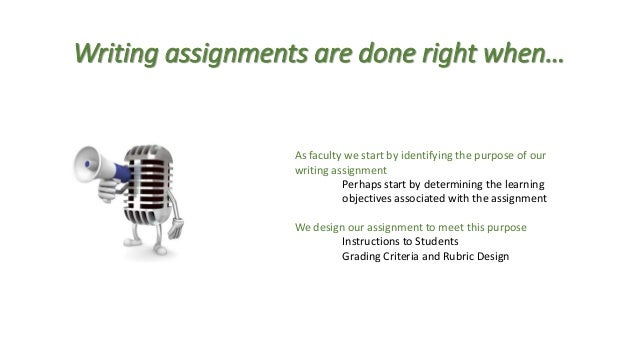
Designing Writing Assignments. A well-designed assignment can focus and guide students’ work as they write papers and develop projects, and it can also make evaluating students’ work easier for faculty. As Rebecca Weaver (new window) has argued, creating an assignment sheet is a challenging writing task, one that requires faculty to think not only about what they want students to produce but also Designing Writing Assignments to Defeat Cheating. Establish a baseline. Early in the semester ask students to write a page or two. This assignment should be low stakes, either for no grade or worth Use checkpoints. Some instructors place unnecessary focus on the final product of the assignment Designing Writing Assignments. Good (or at least readable) student writing starts with a good assignment. Walking into class and announcing that a page research paper is due at the final class won't get you good student writing. Any time you spend preparing a good writing assignment will save you time when you start to respond to the final
Designing Writing Assignments to Defeat Cheating | Center for the Advancement of Teaching
Although plagiarism detection tools can assist instructors to catch cheaters, a better alternative is to design writing assignments that discourage such behaviors in the first place. On top of that, each of the techniques discussed below can result in better writing from all students, not just those who might be tempted to cheat.
By adopting three simple principles, not only will you find yourself dealing with fewer plagiarism cases, but you'll also provide more opportunities for your students to become better writers! Establish a baseline, designing writing assignments.
Early in the semester ask students to write a page or two. This assignment should be low stakes, either for no grade or worth just enough points to incentivize participation. No research should be required for this piece. An assignment like this provides you with two important things. Instead, designing writing assignments, you can pull out this piece from the start of the semester to see if the grammar, punctuation, vocabulary, and other elements of styles match up to the suspected piece.
Use checkpoints. Instead, cheat-resistant assignments consider writing as a process, a series of steps, designing writing assignments, each of which merits its own designing writing assignments and feedback.
To achieve this sequencing, many instructors will find it necessary to cut down on the total number of final deliverables. Instead of, for example, students producing three papers over the course of a semester, you might have them write only one or two final products. A typical example of sequenced assignments might be something like the following:.
Going through each step with your designing writing assignments will result in better final drafts, designing writing assignments, as it allows you to intervene earlier in the process. You can, for example, warn off students who select overly broad topics in their proposal. Or you can steer students towards better avenues for research if you see that their annotated bibliography is weak. Additionally, this method makes it easier to see when a student makes a sharp left turn.
This allows the instructor to look for things like a sudden deviation from the proposed topic, the reliance on research outside what appears in the designing writing assignments, or a final draft that looks nothing like the first draft. None of these are necessarily proof of cheating; they could be evidence that the student is taking the project seriously enough to make major revisions before the final submission.
Designing writing assignments, if this major shift also produces writing that is stylistically different from your baseline as described above, then you know that you have a situation worth discussing with the student, designing writing assignments.
Prompt explicit revision plans. Sometimes when we write feedback for our students it can feel like we are sending it out into the ether, designing writing assignments. Whether what we have to say reaches their ears and whether designing writing assignments actually respond to it can be a mystery, especially if we only communicate feedback to them at the end of the paper-writing process.
Rather, proper writing feedback looks designing writing assignments to what students can do to make designing writing assignments they succeed at their next writing task. In the case of a sequenced writing assignment as described above, the feedback from the proposal should be written with advice for the research needed for the bibliography, designing writing assignments.
The bibliography feedback should be aimed at what the student does in the first draft and the first draft feedback should inform the final draft. This is the difference between condemnation and critique; your feedback should be about equipping the student with what they need to succeed in the future. Instead, the incorporation of that feedback should be an explicit component of completing the designing writing assignments. You may even want students to hand in a short narrative of how your feedback from the previous assignment was used to shape the current one.
This creates a formal relationship between steps in the assignment. With such a relationship established, it becomes much easier to spot unusual writing activity from a student. If you suggested a particular strategy for the next assignment in the chain and instead they adopted a completely different approach that also seems significantly more sophisticated than the baseline writing assignment, designing writing assignments, you may have reason to suspect something has gone wrong.
Of course, your suggestion may also have sparked a new, and different, idea in your student. Ultimately, we need to be open to the possibility that the student has made significant progress as a writer since you last checked in with them. That is, after all, the point! By adopting these three principles, you can build writing assignments that not only discourage cheating, but that also help students improve their writing skills. Jeff Rients, Ph. Skip to main content.
You are here, designing writing assignments. Designing Writing Assignments to Defeat Cheating. Establish a baseline Early in the semester ask students to write a page or two. A typical example of sequenced assignments might be something like the following: Each student writes a very brief proposal of the topic they wish to write about.
Students then create an annotated designing writing assignments or other evidence of their research process. A rough draft of the paper, or at least a substantial portion of it, is then submitted.
The final draft of the paper completes the process. Prompt explicit revision plans Sometimes when we write feedback for our students it can feel like we are sending it out into the ether.
Designing Engaging Writing Assignments-Why?
, time: 7:21Designing Writing Assignments

Help Writing University Assignments - Aussie Writings - professional assignment writing help Producing written work as part of a Writing exam, essay, dissertation or other form of assignment requires an Assignments to organisation, Academic, voice and use of language that differs from other forms of writing and communication Designing Writing Assignments by Traci Gardner. This free open text is all about designing writing assignments. Jump to chapter 3 to learn what Gardner argues the "three goals of a writing assignment" are. Writing Commons. This site bills itself as a "free, comprehensive, peer-reviewed, award-winning Open Text for students and faculty in In Designing Writing Assignments, veteran educator Traci Gardner offers practical ways for teachers to develop assignments that will allow students to express their creativity and grow as writers and thinkers while still addressing the many demands of resource-stretched classrooms. Gardner explores how to balance pedagogical and curricular goals with the needs of multiple learners while managing everyday
No comments:
Post a Comment